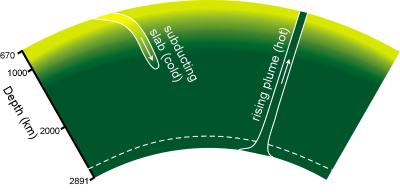- Home
- News
- General News
- Unusual iron discovered...
Unusual iron discovered deep inside the Earth
16-09-2008
Research performed at the ESRF on the Earth’s most abundant mineral has revealed a dramatic change in iron deep inside the Earth, explaining controversial observations that have puzzled scientists for several years. Iron changes to an unusual electron structure that is apparently stable throughout most of the deep Earth. These new findings challenge current models of the Earth’s interior, because they probably change what is known about the physical and chemical properties of the Earth’s most abundant mineral, and hence the characteristics of the lower mantle. This discovery, completely unexpected according to theoretical predictions, is published today in Nature Geoscience.
Share
The Earth’s interior is mostly inaccessible, so one method that scientists use to predict its behaviour is to construct models from geophysical data (for example, from earthquakes) and measurements made in the laboratory. Such models tell us not only how properties such as temperature and chemistry change with depth, but also how the movement of material inside the Earth affects surface processes such as plate tectonics and the chemistry of the atmosphere.
Many laboratory studies on the Earth’s most abundant mineral, a magnesium and iron-containing silicate with the perovskite structure (“lower mantle perovskite”), have not included iron because experiments are easier to perform without this element. However, iron is a transition element and can change its electronic structure and, consequently, the way the Earth’s interior behaves. Spin state transitions, for example, are changes in the pairing of electrons in the atomic orbitals, which for ferrous iron can be high spin (four unpaired electrons), intermediate spin (two unpaired electrons) and low spin (no unpaired electrons). Spin state transitions in lower mantle peroskite have been studied since 2004, but each study so far has reached a different conclusion. The spin state of iron in lower mantle perovskite has remained a puzzle.
Researchers from the University of Bayreuth (Germany) and the ESRF have now found clear evidence of a spin transition in lower mantle perovskite. They used beamline ID18 to study lower mantle perovskite at high pressure and high temperature using a diamond anvil cell fitted with a miniature heater, and were able to reach 110 GPa (1.1 million times atmospheric pressure), which is almost the pressure of the Earth’s core. They made parallel studies of the same sample at the University of Bayreuth as well as on beamline ID27 and at the Advanced Photon Source (USA), and found that iron in lower mantle perovskite is predominantly in the intermediate-spin state throughout most of the lower mantle.
The unexpected stability of the intermediate-spin state is probably related to the unusual environment of the iron atom in lower mantle perovskite. Computer simulations have so far failed to reproduce the stability of intermediate-spin iron using conventional approaches, suggesting that more complex models are needed to recreate what nature has already produced.
The new results suggest that some of the assumptions on which Earth models are based will have to change. Just how much they might change will be decided by the results of upcoming high-pressure experiments. “It’s always exciting to discover something new about the Earth’s interior, particularly when it changes our ideas. Who knows what other surprises are waiting for us”, explains Catherine McCammon, main author of the paper.
References
McCammon, C., Kantor, I., Narygina, O., Rouquette, J., Ponkratz, U., Sergueev, I., Mezouar, M., Prakapenka, V., and Dubrovinsky, L. (2008) Stable intermediate-spin ferrous iron in lower mantle perovskite. Nature Geoscience, doi: 10.1038/ngeo309.
Top image: A view inside the Earth to the lower mantle, which consists mostly of lower mantle perovskite (inset). In the crystal structure the iron atoms (green) are in a distorted atomic environment.Credits: C.McCammon.




